Last time she saved the world. This time it's personal.Tagline
Final Fantasy X-2 is the direct sequel to Final Fantasy X, developed and published by Square Enix. It was released in March 2003 for the PlayStation 2. It's since been re-released as part of the Final Fantasy X/X-2 HD Remaster for PlayStation 3 and PlayStation Vita in 2013, for PlayStation 4 in 2015, and Microsoft Windows in 2016. It was directed by Motomu Toriyama, with Tetsuya Nomura providing the character design and both Noriko Matsueda and Takahito Eguchi composing the score. It was the first direct sequel game in the Final Fantasy series and the first to feature an all-female playable cast. It also returned to the job system not seen in the main series since Final Fantasy V.
The game takes place in Spira during the Eternal Calm, two years after Final Fantasy X. It continues the story of Yuna, who has become a sphere hunter and a member of the sphere hunting group, the Gullwings, with Rikku and Paine. Yuna hunts for spheres to find clues about a mysterious man who looks like her lost love Tidus. However, she becomes entangled in political turmoil the Gullwings must resolve to prevent a war, uncovering a plot to destroy Spira with a secret weapon from its ancient past.
Final Fantasy X-2 uses a character class system where the equipped dressphere determines her abilities and stats. Party members can switch to any dressphere in their Garment Grid to swap to new skills and adapt to different opponents. It makes use of the Active Time Battle system that was absent from Final Fantasy X. The party has access to all locations early on and can visit them through the Celsius, complete several minigames and sidequests in a chapter before progressing through the story to the next one.
Final Fantasy X-2 received a positive reception from critics and was commercially successful. It has a score of 85/100 on Metacritic,[6] and in 2013, Square Enix announced that Final Fantasy X and Final Fantasy X-2 combined had sold over 14 million copies.[7]
Gameplay

Final Fantasy X-2 uses an interchangeable job system. The party member's abilities vary depending on which dressphere she is wearing. Garment Grids allocate dresspheres to each character for use in battles. The grids have inherent powers activated when equipped or as the player spherechanges by passing through gates. New dresspheres and Garment Grids are acquired from the story and sidequests.
The dressphere system grants the freedom to customize each character's battle style, assigning them jobs mid-battle to adjust their strengths to best suit the opponent's weaknesses. Changing through all the dresspheres on a character's Garment Grid enables them to change into a special dressphere unique to them.
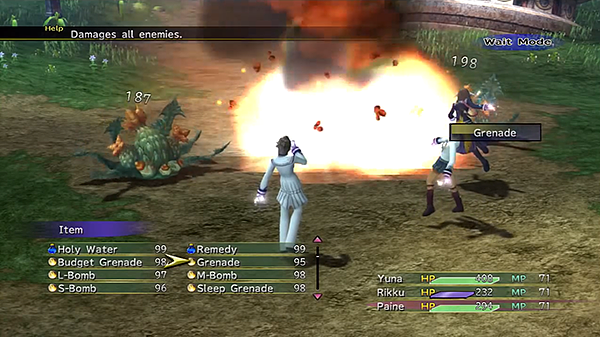
The battle system is the classic Active Time Battle but faster, and party members can take actions simultaneously as opposed to the one-at-a-time system used in previous ATB systems. When a character performs actions and kills enemies, they gain Ability Points that unlock new abilities in their dressphere. When a character chooses a command, there may be charge time before it's executed. The players can chain attacks to stun enemies and deal more damage. As the dressphere determines the character's battle gear, the player can only equip accessories.
Final Fantasy X-2 diverges from its predecessor in many ways, including a fluid mission-based storyline, allowing the player to participate in many sidequests and minigames. A significant portion of the game's events are unnecessary to complete the main storyline; however, much of the story's depth–including characterization and background details–are featured in the optional content, which generally follows how each part of Spira is healing in the time since Sin's passing.

The mission-based system allows the player to create their own journey, making the story somewhat non-linear. It is up to the player to determine which and how many sidequests to attempt and complete. The game is divided into five chapters, and most locations have a new quest to undertake each chapter. For the first time, the player can access most areas early in the game. Several quests encompass the entire game, while others can only be started during a specific chapter. There is a special cutscene after the end credits for those who complete the game with 100%.
Episode Complete is a result that players can achieve within each area in the final chapter. Getting an Episode Complete provides the most satisfactory outcome for a location; obtaining Episode Complete for all regions in a single playthrough awards the player with the ultimate dressphere, Mascot. If the player doesn't get Episode Complete, they may get Episode Concluded instead, to signify the player has concluded all events in the area.
Minigames, such as blitzball, chocobo raising, excavating in the Bikanel Desert, and the new coin game, Sphere Break, make diversions to the game's main plot.
Synopsis
Setting
Spira entered an Eternal Calm two years ago when Yuna and her guardians defeated Sin for good. The temple of Yevon crumbled as Spirans learned of its corrupted ways and how following its precepts was never a path to salvation from Sin. With the Yevon faith disbanded and the temples' fayth having departed to the Farplane, the afterlife plane in Spira, the summoners' means to call forth aeons is also gone, along with the rite of the pilgrimage. Thus, some now view summoners as obsolete. The fayth's disappearance has had some positive and negative effects on the broader world; among them are the Floating Ruins' reveal at Mt. Gagazet, the melting of Lake Macalania, and Macalania Woods' magical flora withering.
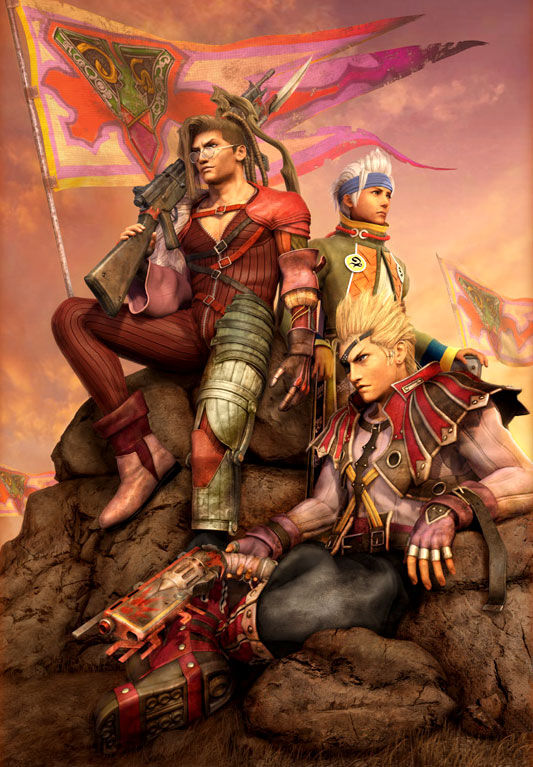
Yevon's fall created a power vacuum that newly-founded groups are seeking to fill. The Youth League, led by Maevyn Nooj, wants to unveil Spira's real past it considers concealed by Yevon. Its members frequently clash with New Yevon followers, accusing them of continuing down the path set by Yevon in oppressing Spirans and keeping them in the dark of many truths. New Yevon is led by Praetor Baralai with the motto "One thing at a time," to ease Spira into a new way of life gradually.
As the ban on machina was lifted in the wake of Yevon's downfall, Spirans no longer vilify the Al Bhed, enabling them to mingle with other Spirans more freely as Spira begins to adopt automation to ease everyday life. The Al Bhed group, the Machine Faction, led by Gippal, aids this effort. Its goal is to change public perception of the previously forbidden technology by calling them "machines" rather than machina and introducing its benefits to the broader society.
The Guado were exiled from their homeland, with many blaming their tribesmen for aiding Seymour Guado, the late maester of Yevon who tried to eradicate Spira by becoming Sin. Many of the Ronso, guardians of Mt. Gagazet, swear vengeance for Seymour's actions, who killed many Ronso in his quest to apprehend Yuna's party.
Characters
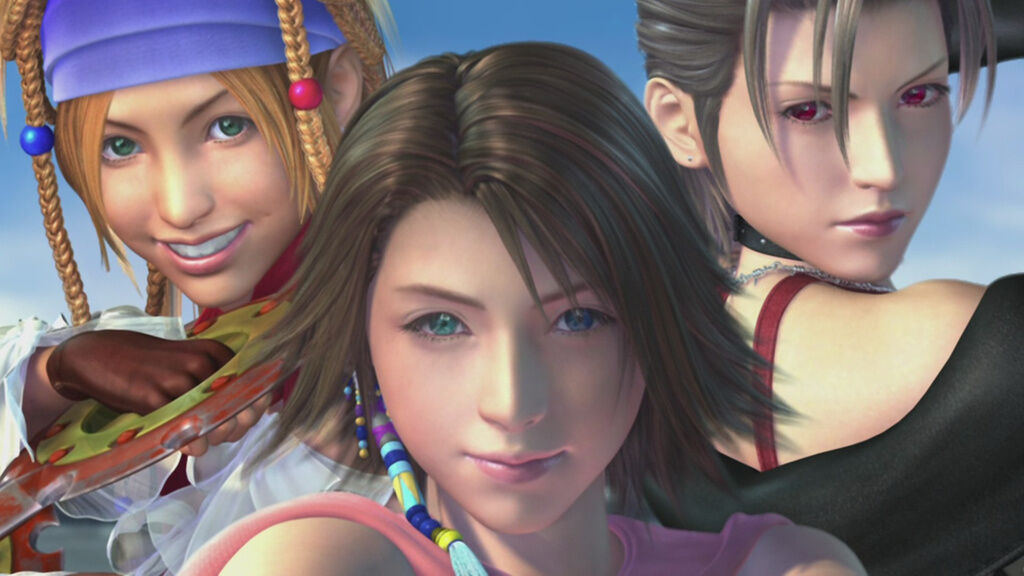
The playable cast is set early, and in a first for the series, only three characters are playable, and they're all female. The player controls Yuna, Rikku, and Paine, leaving the job system as the angle for variation.
- Yuna: The high summoner who defeated Sin and brought Spira the Eternal Calm two years ago. After Rikku showed her a sphere recording of a man resembling her lost love, Yuna left her uneventful life on Besaid and became a sphere hunter and member of the Gullwings for the chance to find more clues and reunite with him.
- Rikku: A lively Al Bhed girl, the Al Bhed leader Cid's daughter, Gullwings' founder Brother's younger sister, and Yuna's younger cousin. Rikku previously served as Yuna's youngest guardian during her pilgrimage two years prior. Believing Yuna should now have some fun in her life and do something for herself, Rikku gifted her with a new outfit, convinced her to join the Gullwings, and embark on a personal journey.
- Paine: A mysterious young warrior woman who joined the Gullwings shortly before Yuna. Paine is cynical, keeps her distance, and only reveals anything about herself when necessary. She has ties to Spira's leaders—Nooj, Baralai, and Gippal—but doesn't like to talk about her past.
Story
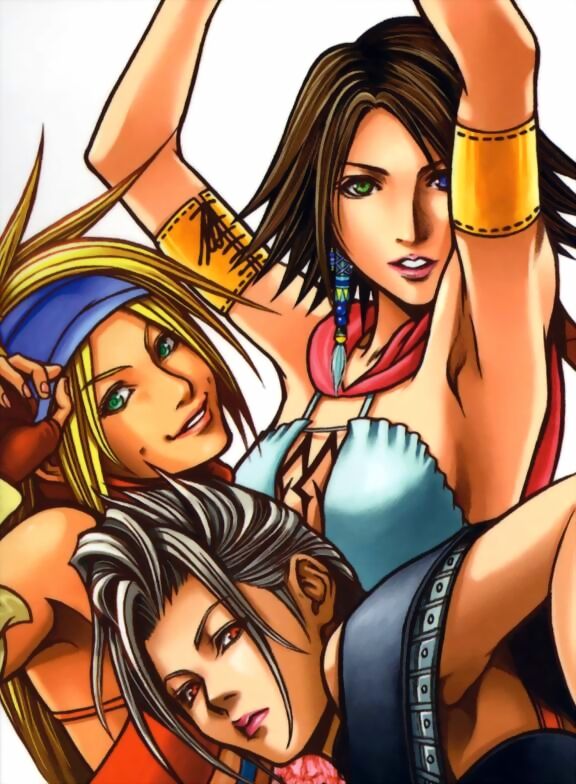
After Sin's defeat two years ago, Spira now has three new leading factions since Yevon's fall left a power void: the Youth League, New Yevon, and the Machine Faction, led by Nooj, Baralai, and Gippal, respectively. Yuna has joined the Al Bhed sphere hunting group, the Gullwings, and goes on missions with Rikku and their new friend Paine while traveling Spira on their airship, the Celsius. She has an old sphere recording showing images of a man resembling Tidus and is on the hunt to find more with hopes of solving the mystery. During their missions, the Gullwings develop a rivalry with the Leblanc Syndicate, another sphere hunting group. New technology developed by the Al Bhed whiz kid Shinra, who travels with the Gullwings, allows the girls to use the spheres they uncover as dresspheres, and the crystallized memories within the spheres empower them in battle. One such sphere, which the Gullwings use as the Songstress dressphere, has an unusual affinity with Yuna, making her feel ancient emotions that intrigue her.
They find a sphere containing images of a colossal machina weapon known as Vegnagun originating from the Machina War a thousand years ago. Vegnagun is powerful enough to destroy Spira itself, and is being roused by the ancient spirit of Shuyin, or rather, his feelings of despair and anguish that have imprinted onto pyreflies and begun acting independently. Shuyin's spirit has possessed Nooj whom he has seek out Vegnagun hidden in the Bevelle Underground, but Nooj is not under Shuyin's complete control and wants to destroy the weapon. Sensing Nooj's intentions, Vegnagun burrows underground and flees to the Farplane, the otherworldly afterlife realm inside the planet.
Nooj's old friends, Baralai and Gippal, pursue him, unable to fathom Nooj's changed demeanor and inconsistent actions. When the two confront Nooj beneath Bevelle, Shuyin's spirit abandons Nooj to possess Baralai and takes him to the Farplane to find Vegnagun. Spira's leaders' absence causes discord between the Youth League and New Yevon, and Yuna becomes embroiled in the events. Shuyin sends fiends to pour out of the former temples' Chambers of the Fayth. The Gullwings stop them from destroying the villages where the temples are located, encountering the aeons possessed by Shuyin's despair. During one such mission, Yuna falls into the hole where the fiends are emerging and finds herself in the Farplane, where she meets Shuyin in Baralai's host body.
Shuyin mistakes Yuna for Lenne, an ancient summoner and Shuyin's lover, whose emotions and memories comprise Yuna's Songstress dressphere. Shuyin is the man who resembles Tidus, whose image had prompted Yuna to embark on her new journey. However, his personality is nothing alike: 1000 years of reliving the memory of dying with Lenne has manifested as a desire to destroy the world. After dissolving the tension between New Yevon and the Youth League, the Gullwings follow Shuyin to the heart of the Farplane, where he is attempting to activate Vegnagun. Shuyin gains a corporeal form when he abandons Baralai, and the Gullwings defeat him in battle. Lenne's spirit emerges from Yuna's dressphere and puts Shuyin's soul to rest, and they fade away together.
The Gullwings return to Spira, where Nooj, Baralai, and Gippal address the populace to announce their pursuit of world peace as a united front. Yuna returns to Besaid, where she has a chance to reunite with a revived Tidus if she asked the fayth to return him to the world while she was in the Farplane.
Final Fantasy X-2.5 ~Eien no Daishō~
In a companion novel, soon after reuniting, Yuna and Tidus end up shipwrecked on an unknown island and come in contact with ghosts of the Machina War.
Last Mission
Three months later, Yuna, Rikku, and Paine each receive a letter asking the trio to reunite and investigate the newly discovered Iutycyr Tower, catching up with what each of them has been doing since going their separate ways.
Final Fantasy X -Will-
Six months after YRP's reunion, Chuami and Kurgum, two members of the new Spira Council, ask Yuna to investigate strange phenomena occurring due to the Farplane's unstable state, soon discovering the return of an old enemy. Meanwhile, Chuami claims to link to one of the legendary guardians who saved Spira from Sin.
Themes
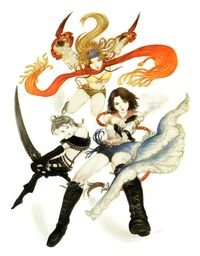
The central theme of Final Fantasy X-2 is searching for the lost, as Kimahri's discovery prompts Yuna to set on a journey to find her lost love. The theme of memories and how they affect people is also prominent. Yuna, Rikku, and Paine think about past events and find strength in them to keep going and look towards the future. As Shuyin's despair over the Machina War and his failure to save Lenne grew over a millennium and began acting on its own, he became a monster who wanted to destroy Spira. By acting as Lenne's vessel, Yuna is able to express Lenne's memories and emotions, including the pain that results from war, and stop Spirans from repeating their past mistakes and help Shuyin find peace.
Another prominent theme is friendship. Paine joins the Gullwings and initially keeps to herself but learns to open up, despite Yuna and Rikku often annoying her. The party discovers Paine's past friendship with Nooj, Gippal, and Baralai, one of Paine's reasons for joining the Gullwings.
Yuna's journey is that of self-discovery. No longer a summoner, Yuna isn't burdened by the profession's responsibilities and is free to embrace the life she once believed she'd have to sacrifice for Spira's sake. Through her time under Rikku's influence, Yuna finds her place in the new Spira and finds a strong and confident woman inside herself.[8]
Additional themes are human conflict and change. Spira has changed since Sin's defeat and the arrival of the Eternal Calm. A reformed Yevon fights with the recently formed Youth League over the control of Spira's future, while the Machine Faction tries to remain neutral by supplying machina to both sides. Now that Sin is gone, the people are free to have fun in life, no longer subject to Yevon's false teachings. However, they have to deal with the repercussions of the actions taken to achieve that independence and the people whose lives were lost in the process and come to terms with the winds of change overtaking Spira and the consequences brought with progress.
Development
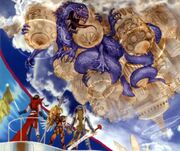
Final Fantasy X wasn't originally planned to have a sequel. After a strong fan reaction to the short story titled Eternal Calm included with Final Fantasy X International, the development team decided to continue the story.[9] Producer Yoshinori Kitase has commented that at the time, the team was ready for a new challenge and thought creating a sequel to Final Fantasy X would be a kind of challenge they hadn't yet tried.
One of the biggest challenges was what to call the sequel, and "X-2" was initially rejected under the assumption it could be mistaken for Final Fantasy XII.[10]
The developers didn't want Final Fantasy X-2 to be a mere extension of the previous game. Even before the team had completed the sequel's story, they had worked on recreating Yuna's look and decided on a story to fit that style.[9] In the beginning, the team decided on an action-adventure game with a trio of female characters; the decision to have a female cast was one of the new challenges the developers wanted to try out with the game. One other discussed approach was depicting the story of Jecht and Auron's generation. However, the idea was scrapped for being too traditional and because the team didn't want a game with no female playable characters.[11]
Director Motomu Toriyama has commended that it's not uncommon for women to star as main characters in Hollywood movies. The team looked into films like Charlie's Angels and Tomb Raider for inspiration,[8] but the Hollywood stories were using "macho" women to fill the same type of roles usually played by men. With Final Fantasy X-2, the team used ideas from movies as a starting point, but the goal was to base the story around cuter and more feminine characters.[8] They achieved this by offering various outfits for the party, using ladylike movements in battle, and the group's energetic reactions to events to keep the atmosphere lighthearted and reinforce the heroines' cuter aspects.[8]
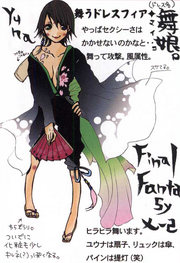
The developers wanted a change from the previous game's theme. The Final Fantasy X theme was described as independence from the ties of law and customs. In contrast, Final Fantasy X-2 was about the changes caused by the chaos after gaining that independence. In Final Fantasy X, each character had something important to face, but in Final Fantasy X-2, the developers wanted to show their journey searching for their new self. To contrast with Final Fantasy X's at times sorrowful atmosphere, Final Fantasy X-2 was to have a "pop" and upbeat tone in the game's beginning.[9] To portray Spira's change, many locations were redesigned and the game excluded summons and included new vehicles.
Final Fantasy X-2 uses a new version of the ATB system, which lets players time their attacks for combos as the party can act at the same time. The assistant game designer from Final Fantasy X became the lead for its sequel, and spearheaded using a different system.[10] A big new element was dresspheres, which allows the party to switch between different roles in combat on-the-fly. Since the beginning, the team knew that Final Fantasy X-2 wasn't going to have summons and that they would need something to take their place. This dilemma spawned the idea for the spherechange system since it provides something that is appealing both visually and in terms of gameplay.[8] Since Final Fantasy X-2 was the first game in the series to reuse a game world, the developers wanted to offer something new in other areas and took a different approach to the battle system.[8]
The production team was only a third the size of Final Fantasy X because it was already familiar with the previous installment's material and content. They could reuse content, allowing them to develop the game in one year, half the time it usually takes to produce a Final Fantasy title.
One challenge with the localization was getting the tone right, as explained by Brian Grey, who worked on the localization:
Between Yuna's wrist-flapping run, Brother's anime-esque antics, and in-game J-pop musical numbers, FFX-2 is probably the most non-Western looking Final Fantasy approach to date. Everything, from the outfits the girls wear to the character animations to the downright bizarre subplots, is over the top in the Japanese version. To keep things balanced, we decided to write equally unpredictable and lighthearted English dialogue. In the end, American gamers might scratch their heads and say, 'Is this for real?' during some of the more bizarre situations Yuna lands herself in, but the English dialogue never gets so heavy-handed that it forces the gamer to take what they're watching too seriously.Brian Grey, Final Fantasy X-2 localization team[12]
Version differences
Music

The game's music was composed by Noriko Matsueda and Takahito Eguchi, who had also created music for the obscure racing RPG Racing Lagoon in 1999 that was never localized and was developed under the former Squaresoft label. The regular series composer Nobuo Uematsu didn't contribute a single track despite having composed most of the first game's soundtrack. The Final Fantasy X-2 Original Soundtrack was released on two discs in 2003, followed by Final Fantasy X-2 International + Last Mission Original Soundtrack composed of the songs added to Final Fantasy X-2 International + Last Mission.
Final Fantasy X-2 doesn't reuse any tracks from Final Fantasy X. The game's musical style differs from its predecessor's, including many lighthearted and upbeat tracks. Unlike "Suteki Da Ne (Isn't It Wonderful?)", the vocal theme of Final Fantasy X, "real Emotion" and "1000 Words" received English versions for the global release.
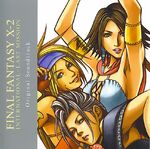
When asked about the chosen composers, the game's director, Motomu Toriyama, stated:
As symbolized in Yuna's live performance in the opening, we wanted to incorporate a pop feeling even with the music this time, which is very different from the typical Final Fantasy world. Ms. Matsueda and Mr. Eguchi were a perfect fit to the changes we were trying to achieve so we asked those two to handle the music for FFX-2. In fact, the drastic change in the music is one of the big differences that gave new direction for FFX-2. I wanted Mr. Uematsu to participate but due to other projects, we weren't able to have him on board for FFX-2.Motomu Toriyama, Final Fantasy X-2 director[9]
Release
Final Fantasy X-2: International + Last Mission
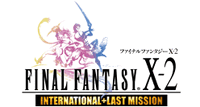
On February 19, 2004 (the day before the European and PAL release of Final Fantasy X-2), a special edition was released in Japan that features two modes: International and Last Mission. While the dialogue is in English (except for Last Mission), the subtitles and menus are in Japanese.
International has general tweaks to the look, feel, speed, and dialogue. It has two extra dresspheres, new Garment Grids, and the inclusion of a Creature Creator system similar to Final Fantasy X's Monster Arena, where fiends can be captured, trained, and used in battle. Notable new fiends include Almighty Shinra (a demonic-energy infused Shinra) and Major Numerus (the final boss of Last Mission, a four-headed snake beast that rivals other Final Fantasy bosses for the spot of most difficult).
Many Final Fantasy X and Final Fantasy X-2 non-player characters can be trained and used in battle, including Tidus, Auron, Seymour, Lulu, and Kimahri, Lucil, Nooj, Baralai, and several others. Players can gain over 150 additional party members through this system, with the majority having their own small storylines and endings (some including familiar faces like Seymour and Jecht).
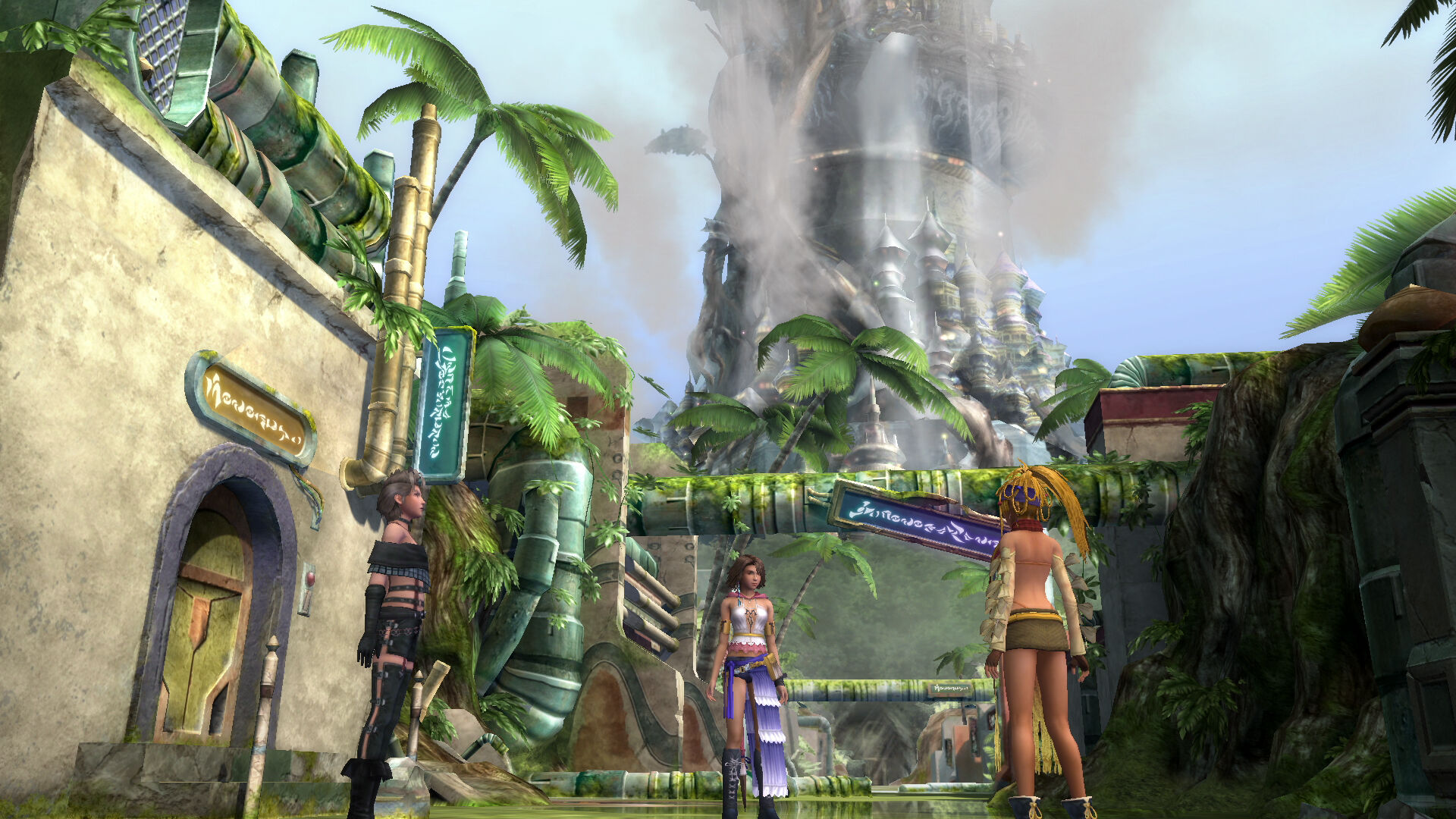
Last Mission is a storyline-based mission set three months following the defeat of Vegnagun where Yuna, Rikku, and Paine meet up for the first time since going their separate ways after their victory to explore the recently-discovered Iutycyr Tower. The tower has 80 levels with a boss battle on every 20th level. On every 10th level, the girls discuss the current events in their lives and Spira, adding post-game conclusions for many people the girls encountered three months prior. These conversations are altered depending on how the player begins the mission.
Selecting New Game at the start screen prompts the player to load a save game file from Final Fantasy X-2 normal or International, or begin without loading. When beginning from scratch, the dialogue is based on the normal ending of Final Fantasy X-2. If the player loads a save game file with the happy or perfect ending, Yuna will talk about her new life with Tidus on Besaid Island on the 30th floor. It is possible to remove certain pieces of dialogue: at one point, the girls mention Wakka and Lulu's baby, Vidina, has had his first tooth, but by loading a save game set before completing Besaid in Chapter 5, the game removes any references to Vidina as the girls haven't met him.
Final Fantasy X/X-2 HD Remaster
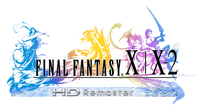
On March 19, 2013, it was confirmed that Final Fantasy X-2 would be receiving an HD remaster alongside Final Fantasy X based on the game's International version. The two games are available together on a single Blu-ray disc for the PlayStation 3 version. PS Vita owners can either download both games digitally for $39.99 or purchase a retail version that comes with a physical copy of Final Fantasy X and a voucher to download Final Fantasy X-2. The HD remaster has trophies and improved music and graphics.
Square Enix announced the PlayStation 4 version via its official site. The game was released in May 2015.
Microsoft Windows (via Steam)
Final Fantasy X/X-2 HD Remaster was listed in Steam's database in December 2015.[13] It was released on May 12, 2016.[5]
Reception
Final Fantasy X-2 sold well; within a few months of its North American release, the game sold a million copies, plus nearly two million copies in Japan.[14] In 2013, Square Enix announced that the Final Fantasy X series had sold over 14 million copies.[7]
The game's stylistic changes from past Final Fantasy titles created controversy. Final Fantasy X-2 was the first playable direct sequel to a Final Fantasy title, and the game's atmosphere was a drastic change from that of Final Fantasy X. The reuse of content also received criticism.
Despite negative comments, the game's critical reception was mostly positive. The game received a score of 85/100 on Metacritic, only slightly down from its predecessor.[6]
Production credits
Staff
| Producer | Yoshinori Kitase |
|---|---|
| Director | Motomu Toriyama |
| Sound Producer & Music | Noriko Matsueda, Takahito Eguchi |
| Main Programmers | Yukio Ishii (field), Masaki Kobayashi (battle) |
| Art Director | Shintaro Takai |
| Character Designer | Tetsuya Nomura |
| Writers | Kazushige Nojima, Daisuke Watanabe |
| Supervising Dialogue Editor | Teruaki Sugawara |
| 3D Map Director | Yohichi Kubo |
| Image Illustrator | Yoshitaka Amano |
| Chief VFX Programmer | Yasunari Ohinishi |
| Sound Programmer | Minoru Akao |
| Real-Time Graphics Director | Yohichi Kubo |
| Lead Menu Designer | Yoichi Machida |
| Menu Programmer | Tomonari Ohnishi |
| Real-Time Programmer | Koji Sugimoto |
| Movie Director | Kazuyuki Ikumori |
| Alternative Costume Designer | Tetsu Tsukamoto |
| Concept Art Director | Toshitaka Matsuda |
| Motion Director | Yoshiyuki Soma |
| Main Character Model Designer | Toshiaki Matsumura |
| Lead Designer | Eiji Fujii |
| Supervising Sound Editor | Chiharu Minekawa |
| Character Supervisor | Taiji Okusawa |
| Configuration Supervisor | Kei Miyamoto |
| Animation Supervisor | Kohichiro Shiratori |
| Motion Capture Supervisor | Masaharu Inoue |
| VFX Supervisors | Koji Tanaka, Yasuharu Yoshizawa |
| Assistant Producer | Hideki Imaizumi |
| Localization Directors | Kazuyoshi Tashiro, Nobuko Kanaya |
Voice cast
| Character | Japanese | English |
|---|---|---|
| Yuna | Mayuko Aoki | Hedy Burress |
| Rikku | Marika Matsumoto | Tara Strong |
| Paine | Megumi Toyoguchi | Gwendoline Yeo |
| Brother | Takayuki Yamaguchi | David Rasner |
| Buddy | Ken Taira | Ogie Banks III |
| Shinra | Akeno Watanabe | Pamela Adlon |
| Barkeep | Junichi Suwabe | John DeMita |
| Nooj | Nobutoshi Kanna | George Newbern |
| Baralai | Kenji Sobu | Josh Gomez |
| Gippal | Kenichi Suzumura | Rick Gomez |
| Leblanc | Satomi Yasuhara | Masasa Moyo |
| Ormi | Kyotaka Furushima | Sarge |
| Logos | Nobuo Tobita | S. Scott Bullock |
| Wakka | Kazuya Nakai | John DiMaggio |
| Lulu | Rio Natsuki | Paula Tiso |
| Kimahri Ronso | Katsumi Cho | John DiMaggio |
| Cid | Koichi Sakaguchi | Michael McShane |
| Dona | Nanaho Katsuragi | Candi Milo |
| Barthello | Jun Ishimaru | John Demita |
| Isaaru | Akio Suyama | Quinton Flynn |
| Maroda | Masataka Nakai | Robbie Rist |
| Pacce | Motoko Kumai | Candi Milo |
| Lucil | Sayaka Ohara | Candi Milo |
| Elma | Sumomo Momomori | Julia Fletcher |
| Clasko | Takayuki Yamaguchi | Matt Miller |
| Beclem | Shunsuke Sakuya | Adam Paul |
| Yaibal | Masataka Nakai | Scott Menville |
| Maechen | Takuma Suzuki | Dwight Schultz |
| Shelinda | Miki Nagasawa | Sherry Lynn |
| Rin | Shunsuke Sakuya | Tom Kenny |
| O'aka XXIII | Hidenari Ugaki | Dwight Schultz |
| Tromell | Ryuzo Ishino | Corey Burton |
| Calli | Rio Natsuki | Cree Summer |
| Tobli | Hideo Ishikawa | Rob Paulsen |
| Nhadala | Sayaka Ohara | Daisy Tormé |
| Benzo | Rio Natsuki | Dee Bradley Baker |
| Garik Ronso | Masatoyo Tetsuno | Jack Fletcher |
| Lian | Rob Paulsen | |
| Ayde | Dee Bradley Baker | |
| Hana | Olivia Hack | |
| Taro | Kath Soucie | |
| Dongo | Phil Proctor | |
| Pukutak | Grey DeLisle | |
| Bahamut's Fayth | Rio Natsuki | Debi Derryberry |
| Seymour Guado | Junichi Suwabe | Alex Fernandez |
| Auron | Hideo Ishikawa | Matt McKenzie |
| Jecht | Masuo Amada | Gregg Berger |
| Braska | Takuma Suzuki | Dee Bradley Baker |
| Shuyin | Masakazu Morita | James Arnold Taylor |
| Lenne | Kumi Koda | Cree Summer |
| Tidus | Masakazu Morita | James Arnold Taylor |
Motion cast
| Character | Actor |
|---|---|
| Yuna | Mayuko Aoki |
| Rikku | Natsuho Matsuda |
| Paine | Yoko Yoshida |
| Nooj | Jun Ishii |
| Baralai | Akihiko Kikuma |
| Tidus/Shuyin | Masakazu Morita |
Packaging artwork








Gallery
Allusions
Final Fantasy X-2 makes numerous allusions to contemporary pop culture, among other subjects.
Trivia
- As Final Fantasy X-2 is set two years after Final Fantasy X, it was also released two years after Final Fantasy X.
- During the first mission in Chapter 1, when the Gullwings race the Leblanc Syndicate to the top of the Floating Ruins, an animated picture resembling the game's logo, but with Leblanc, Logos, and Ormi depicted, is shown at the top of the screen.
- Kingdom Hearts Final Mix contains a trailer for Final Fantasy X-2. Unlimited Saga also includes a trailer for the game.
See also
Citations
- ↑ 1.0 1.1 Final Fantasy X/X-2 HD Release Date Announced
- ↑ http://www.siliconera.com/2015/03/02/final-fantasy-xx-2-hd-remaster-arrives-ps4-may-new-music-switching-option/
- ↑ http://www.jp.square-enix.com/ffx_x-2HD/
- ↑ 4.0 4.1 http://eu.square-enix.com/en/blog/final-fantasy-xx-2-coming-ps4-15th-may-exclusive-steelbook
- ↑ 5.0 5.1 http://store.steampowered.com/app/359870
- ↑ 6.0 6.1 Final Fantasy X-2 Reviews on PlayStation 2 (Accessed: December 30, 2017) at Metacritic
- ↑ 7.0 7.1 "FINAL FANTASY X / X-2 HD Remaster" Release date and price determination announcement (Accessed: December 30, 2017) at Square Enix
- ↑ 8.0 8.1 8.2 8.3 8.4 8.5 Exclusive Final Fantasy X-2 Interview — Gamesradar.com
- ↑ 9.0 9.1 9.2 9.3 http://uk.ps2.ign.com/articles/442/442025p1.html
- ↑ 10.0 10.1 Yoshinori Kitase (2022, January 5). "Final Fantasy X and X-2 producer reflects on the innovative PS2 titles". From PlayStation Blog. Archived from the original on 6 January 2022.
- ↑ http://projectcrystallis.org/square-enix-members-exclusive-final-fantasy-x-x-2-hd-remaster-interview/
- ↑ http://www.ffcompendium.com/h/interview.shtml
- ↑ https://steamdb.info/sub/64178/
- ↑ Final Fantasy X-2 sells a million (Accessed: December 31, 2017) at GameSpot










